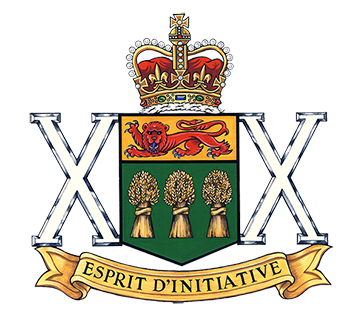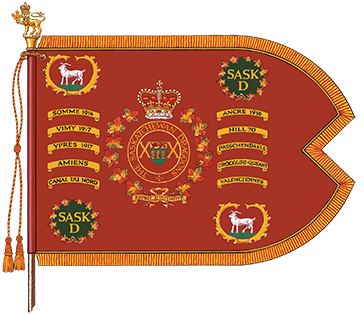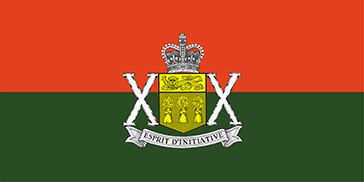The Saskatchewan Dragoons
The official lineage of The Saskatchewan Dragoons armour regiment.

Colonel-in-Chief: His Royal Highness The Earl of Wessex KG, KCVO, SOM, ADC
Badge
Description
The Arms of the Province of Saskatchewan (Vert three garbs in fess Or, on a chief Or a lion passant guardant Gules) ensigned by the Royal Crown proper, supported on either side by the Roman numerals "X" Argent all above a scroll Or inscribed ESPRIT D'INITIATIVE in letters Sable.
Symbolism
The Crown represents service to the Sovereign. The arms of the Province of Saskatchewan represent the geographical basis of the regiment. The Roman numerals "XX" represent the regiment's heritage as the 20th Saskatchewan Armoured Regiment."ESPRIT D'INITIATIVE" is the motto of the regiment.
Motto
ESPRIT D'INITIATIVE (Spirit of initiative)
March
Punjaub
Guidon

Camp flag

Battle honours
The First World War
MOUNT SORREL; SOMME, 1916; Ancre Heights; Ancre, 1916; ARRAS, 1917, '18; Vimy, 1917; HILL 70; YPRES, 1917; Passchendaele; AMIENS; Scarpe, 1918; Drocourt-Quéant; HINDENBURG LINE; Canal du Nord; VALENCIENNES; FRANCE AND FLANDERS, 1916-18.
The Second World War
Lineage
This Reserve Force regiment originated on 3 July 1905 and incorporates the following regiments.
The Saskatchewan Dragoons originated in Regina, Saskatchewan on 3 July 1905, when a 'regiment of infantry' was authorized to be formed in the districts of Assiniboia and Saskatchewan.Footnote 1 It was redesignated: '95th Regiment' on 2 April 1907;Footnote 2 and '95th Saskatchewan Rifles' on 1 June 1909.Footnote 3 On 1 April 1912 the regiment was reorganized as two separate regiments, designated the '105th Regiment' (now 'The North Saskatchewan Regiment') and the '95th Saskatchewan Rifles'.Footnote 4 On 15 March 1920, it was amalgamated with the '60th Rifles of Canada' (see below) and redesignated 'The South Saskatchewan Regiment'.Footnote 5 On 15 May 1924, 'The South Saskatchewan Regiment' was reorganized into five separate regiments, designated: 'The Assiniboia Regiment' (now the '10th Field Artillery Regiment, RCA); 'The Regina Rifle Regiment' (now 'The Royal Regina Rifles'); 'The Weyburn Regiment' (now 'The South Saskatchewan Regiment'); 'The Saskatchewan Border Regiment' (now 'The South Saskatchewan Regiment'); and 'The South Saskatchewan Regiment'.Footnote 6 It was redesignated 'The King's Own Rifles of Canada' on 15 September 1924.Footnote 7 On 15 December 1936, it was amalgamated with 'B Company' of the '12th Machine Gun Battalion, CMGC' (now 'The Royal Regina Rifles') and redesignated 'The King's Own Rifles of Canada (MG)'.Footnote 8 It was redesignated: '2nd Battalion, The King's Own Rifles of Canada' on 29 January 1942;Footnote 9 and upon conversion to armour, '20th (Saskatchewan) Armoured Regiment, RCAC' on 1 April 1946;Footnote 10 '20th Saskatchewan Armoured Regiment' on 4 February 1949;Footnote 11 'The Saskatchewan Dragoons (20th Armoured Regiment)' on 31 July 1954;Footnote 12 and 'The Saskatchewan Dragoons' on 19 May 1958.Footnote 13
Notes:
Upon redesignation as The South Saskatchewan Regiment on 15 March 1920 (see above), it was organized as a five battalion regiment with the 1st Battalion (28th Battalion, CEF) and 2nd Battalion (46th Battalion, CEF) on the Non Permanent Active Militia order of battle, and the 3rd Battalion (68th Battalion, CEF), 4th Battalion (128th Battalion, CEF), and 5th Battalion (195th Battalion, CEF) on the Reserve order of battle.
On 1 October 1920, it was organized as a ten battalion regiment with the 1st Battalion (28th Battalion, CEF), 2nd Battalion (46th Battalion, CEF), 3rd Battalion (no CEF designation), 4th Battalion (no CEF designation), and 5th Battalion (no CEF designation) on the Non Permanent Active Militia order of battle, and the 6th Battalion (68th Battalion, CEF), 7th Battalion (128th Battalion, CEF), 8th Battalion (195th Battalion, CEF), 9th Battalion (no CEF designation) and 10th Battalion (no CEF designation) on the Reserve order of battle (GO 160/20).
The South Saskatchewan Regiment was disbanded for the purpose of reorganization on 1 October 1920 and reorganized the same day (GO 232/20). This change was administrative and does not affect the lineage of the regiment.
Upon the reorganization of 15 May 1924 (see above), it was authorized a 1st Battalion on the Non Permanent Active Militia order of battle and a 2nd Battalion on the Reserve order of battle.
Upon redesignation as The Kings Own Rifles of Canada on 15 September 1924 (see above), the 1st Battalion was redesignated the 1st Battalion (46th Battalion, CEF) and the 2nd Battalion the 2nd Battalion (128th Battalion, CEF). The reserve unit was disbanded on 14 December 1936 (GO 3/37).
The King's Own Rifles of Canada were disbanded for the purpose amalgamation on 14 December 1936 and reorganized the next day (GO 194/36). This change was administrative and does not affect the lineage of the regiment.
The perpetuation of the 12th Machine Gun Battalion, CMGC (1919-1936) was assigned to The Regina Rifle Regiment (now The Royal Regina Rifles) (GO 149/37).
The Saskatchewan Dragoons were restricted to one squadron on 1 September 1970 (CFOO 70/15).
The 60th Rifles of Canada originated in Moose Jaw, Saskatchewan on 2 January 1913, when the '60th Rifles of Canada' were authorized to be formed.Footnote 14 On 15 March 1920, it was amalgamated with the '95th Saskatchewan Rifles', as above.
Perpetuations
'46th', and '128th "Overseas" Battalion(s), CEF'
Headquarters Location
Moose Jaw, Saskatchewan
Operational history
The First World War
Details of the 60th Rifles of Canada were placed on active service on 6 August 1914 for local protective duty.Footnote 15
Details of the 95th Saskatchewan Rifles were placed on active service on 6 August 1914 for local protective duty.Footnote 16
The 46th Battalion, which was authorized on 7 November 1914 as the '46th Battalion, CEF',Footnote 17 embarked for Britain on 23 October 1915.Footnote 18 On 11 August 1916 it disembarked in France,Footnote 19 where it fought with the 10th Infantry Brigade, 4th Canadian Division in France and Flanders until the end of the war.Footnote 20 The battalion was disbanded on 30 August 1920.Footnote 21
The 128th Battalion, which was authorized on 22 December 1915 as the '128th "Overseas" Battalion, CEF',Footnote 22 embarked for Britain on 15 August 1916.Footnote 23 The battalion provided reinforcements to the Canadian Corps in the field until 13 February 1917, when it was allotted to the 13th Infantry Brigade, 5th Canadian Division in England.Footnote 24 On 27 May 1917 its personnel were absorbed by the 19th Reserve Battalion, CEF'.Footnote 25 The battalion was disbanded on 30 August 1920.Footnote 26
The Second World War
The regiment mobilized the '1st Battalion, The King's Own Rifles of Canada, CASF' for active service on 29 January 1942.Footnote 27 The unit served in Canada in a home defence role as part of the 14th Infantry Brigade, 8th Canadian Division.Footnote 28 The battalion was disbanded on 30 March 1946.Footnote 29
Page details
- Date modified: